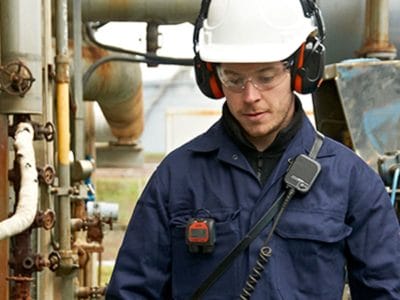
Monitoring Nitrogen Dioxide
Formula: NO2 | CAS: 10102-44-0
The U.S. EPA has set safety levels for environmental exposure to NO2 at 100 ppb, averaged over one hour, and 53 ppb, averaged annually.
However, NO2 concentrations in vehicles and near roadways are appreciably higher than those measured at monitors in the current network. In fact, in-vehicle concentrations can be 2–3 times higher than measured at nearby area-wide monitors. Near-roadway (within about 50 metres (160 ft) concentrations of NO2 have been measured to be approximately 30 to 100% higher than concentrations away from roadways.
The Basics of Detecting Nitrogen Dioxide
Properties | Exposure | Reduction
Nitrogen dioxide is an important atmospheric trace gas, not only because of its human health effects but also because as it absorbs visible solar radiation and contributes to impaired atmospheric visibility; as an absorber of visible radiation it could have a potential direct role in global climate change if its concentrations were to become high enough.
NO2 primarily gets in the air from the burning of fuel. NO2 forms from emissions from cars, trucks and buses, power plants, and off-road equipment. Indoors, exposure arises from cigarette smoke and butane and kerosene heaters and stoves.
– EPA (United States Environmental Protection Agency)
”EPA’s national and regional rules to reduce emissions of NO2 and NOx will help state and local governments meet the National Ambient Air Quality Standard (NAAQS). EPA identifies areas where the air quality does not meet the national NO2 standards. For these areas, state, local, and tribal governments develop plans to reduce the amount ofNO2 in the air.
EPA - Environmental Protection Agency
How Does Nitrogen Dioxide Effect Human Health?
NO2 along with other NOx reacts with other chemicals in the air to form both particulate matter and ozone. Both are also harmful when inhaled due to effects on the respiratory system.
– EPA (United States Environmental Protection Agency)
When side effects do happen, they often occur as the result of inhaling too much of the gas or inhaling the gas too fast.
Common short-term side effects include;
- Excessive sweating


- Shivering
- Nausea
- Vomiting
- Dizziness
- Fatigue
How Does Nitrogen Dioxide Effect The Environment?
NO2 and other NOx interact with water, oxygen and other chemicals in the atmosphere to form acid rain. Acid rain harms sensitive ecosystems such as lakes and forests. Together they can form secondary pollutants and can result in environmental problems such as acidification and nitrogen enrichment.
Nitrogen dioxide is part of a group of gaseous air pollutants produced as a result of road traffic and other fossil fuel combustion processes.
Its presence in air contributes to the formation and modification of other air pollutants, such as ozone and particulate matter, and to acid rain.
– GreenFacts
Download our FREE Guide
“The Basics of Detecting Nitrogen Dioxide”
The basics of detecting nitrogen dioxide guide which can be downloaded below provides the reader with an in-depth balance of knowledge covering the main properties, exposure and reduction of nitrogen dioxide. It primarily gets in the air from the burning of fuel, emissions from cars, trucks and buses, power plants, and off-road equipment. Indoors, exposure arises from cigarette smoke and butane and kerosene heaters and stoves. Workers in industries where the gas is used are also exposed and are at risk.
















